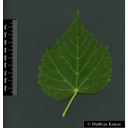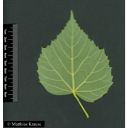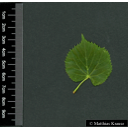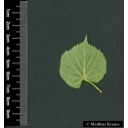Useful information about the taxon (species, subspecies, variety...)
Tilia mongolica Maxim. 1880
Malvaceae
(APG IV)Mongolian lime, Mongolian linden
Akzessionnummer: LG-X-198-17917
Pflanzjahr: 2000
Patenschaftstext: 15.10.2006 Caroline Heimberger-Schlipf
Taxon concept: The Plant List (2014), version 1.1
Distribution: Mongolia, northern China
Tilia mongolica Maxim. - Accepted: Tilia mongolica Maxim. bei The Plant List (2014), version 1.1; Familie: Malvaceae (APG III)
- Flowers
- hermaphrodite flowers
- Flower ecology
- insect-pollinated (entomophilous)
- Life form
- tree
- Leaves
- heart-shaped, dark green
- Foliage persistence
- deciduous
- Fruits
- small grey ovoid, felt-like haired nutlets in a infructescence accompanied by a bract
- Fruit ecology
- wind-dispersed (anemochorous)
- Natural occurrence (habitat)
- limestone mountain slopes, loess-covered hills, deciduous oak forests
- Vegetation typ and synecology (plant community)
- temperate, broad-leaved deciduous forests
- Usage
- a tea made from the flowers has antispasmodic, diaphoretic and sedative properties; used as chocolate substitute made from a paste of the ground fruits and flowers
- Bark
- greyish brown, smooth bark
Erhardt, W., Götz, E., Bödeker, N. & Seybold, S. (2008): Der große Zander. Enzyklopädie der Pflanzennamen. Band 2. Arten und Sorten. Eugen Ulmer KG, Stuttgart (Hohenheim), 18. Aufl., 2103 S.; The International Plant Names Index (2009). Published on the Internet http://www.ipni.org; Courtesy to IPNI, 2009. Exported from IPNI at date: 2009-09-22 20:17:51;
Diese Webseite verwendet Google Maps, um Karten und Standorte von Pflanzen in den Hohenheimer Gärten anzuzeigen. Dadurch werden unter Umständen Daten an Google weitergeleitet, was mit einer Verarbeitung Ihrer personenbezogenen Daten verbunden sein kann. Die Datenschutzerklärung von Google finden Sie hier: Datenschutzerklärung von Google




